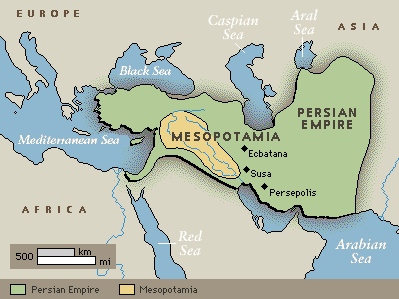Mesopotamia

Mesopotamia (Greek, "between the rivers"), one of the earliest centers of urban civilization, in the area of modern Iraq and eastern Syria between the Tigris and Euphrates rivers.
As the Tigris and Euphrates flow south out of Turkey, they are 400 km (250 mi) apart; the Euphrates runs south and east for 1300 km (800 mi) and the Tigris flows south for 885 km (550 mi) before they join, reaching the Persian Gulf as the Shatt al Arab. The river valleys and plains of Mesopotamia are open to attack from the rivers, the northern and eastern hills, and the Arabian Desert and Syrian steppe to the west. Mesopotamia's richness always attracted its poorer neighbors, and its history is a pattern of infiltration and invasion. Rainfall is sparse in most of the region, but when irrigated by canals the fertile soil yields heavy crops. In the south, date palms grow, supplying rich food, useful fiber, wood, and fodder. Both rivers have fish, and the southern marshes contain wildfowl.
The need for self-defense and irrigation led the ancient Mesopotamians to organize and build canals and walled settlements. After 6000 BC the settlements grew, becoming cities by the 4th millennium BC. The oldest settlement in the area is believed to be Eridu, but the best example is Erech (Uruk) in the south, where mud-brick temples were decorated with fine metalwork and stonework, and growing administrative needs stimulated the invention of a form of writing, cuneiform. The Sumerians were probably responsible for this early urban culture, which spread north up the Euphrates. Important Sumerian cities, besides the two mentioned above, were Adab, Isin, Kish, Larsa, Nippur, and Ur.
Bibliography:
-
"Mesopotamia," Microsoft(R) Encarta(R) 98 Encyclopedia. (c) 1993-1997 Microsoft Corporation. All rights reserved.
